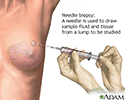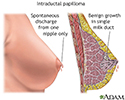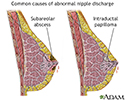Intraductal papilloma
Intraductal papilloma is a small, noncancerous (benign) tumor that grows in a milk duct of the breast.
Tumor
A tumor is an abnormal growth of body tissue. Tumors can be cancerous (malignant) or noncancerous (benign).
Causes
Intraductal papilloma occurs most often in women ages 35 to 55. The causes and risk factors are unknown.
Symptoms
Symptoms include:
-
Breast lump
Breast lump
A breast lump is swelling, a growth, or a lump in the breast. Breast lumps in both men and women raise concern for breast cancer, even though most l...
 ImageRead Article Now Book Mark Article
ImageRead Article Now Book Mark Article - Nipple discharge, which may be clear or bloodstained
These findings may be in just 1 breast or in both breasts.
For the most part, these papillomas do not cause pain.
Exams and Tests
The health care provider might feel a small lump under the nipple, but this lump cannot always be felt. There may be discharge from the nipple.
A mammogram should be performed, but may not show a papilloma. Ultrasound may be helpful.
Other tests include:
-
A breast biopsy to rule out
cancer
. If you have nipple discharge, a surgical biopsy is performed. If you have a lump, sometimes a needle biopsy can be done to make a diagnosis.
Cancer
Cancer is the uncontrolled growth of abnormal cells in the body. Cancerous cells are also called malignant cells.
Read Article Now Book Mark Article - An examination of discharge released from the breast to see if the cells are abnormal (atypical) or indicate cancer.
- An x-ray with contrast dye injected into the affected duct (ductogram). This test has been mostly replaced by ultrasound.
Treatment
The duct is removed with surgery. The cells are checked for cancer ( biopsy ).
Biopsy
A biopsy is the removal of a small piece of tissue for laboratory examination.
Support Groups
There may be support groups for women with breast disease in your area. Ask your provider for a recommendation.
Outlook (Prognosis)
For the most part, intraductal papillomas do not appear to increase the risk for developing breast cancer.
The outcome is excellent for people with 1 papilloma. The risk for cancer may be higher for:
- Women with many papillomas
- Women who get them at an early age
- Women with a family history of cancer
- Women who have abnormal cells in the biopsy
Possible Complications
Complications of surgery can include bleeding, infection, and anesthesia risks. If the biopsy shows cancer, you may need further surgery.
When to Contact a Medical Professional
Call your provider if you notice any breast discharge or a breast lump.
Prevention
There is no known way to prevent intraductal papilloma. Breast self-exams and screening mammograms can help detect the disease early.
Breast self-exams
A breast self-exam is a check-up a woman does at home to look for changes or problems in the breast tissue. Many women feel that doing this is impor...

Mammograms
A mammogram is an x-ray picture of the breasts. It is used to find breast tumors and cancer.

References
Davidson NE. Breast cancer and benign breast disorders. In: Goldman L, Schafer AI, eds. Goldman's Cecil Medicine . 25th ed. Philadelphia, PA: Elsevier Saunders; 2016:chap 198.
Hunt KK, Green MC, Buccholz TA. Diseases of the breast. In: Townsend CM Jr, Beauchamp RD, Evers BM, Mattox KL, eds. Sabiston Textbook of Surgery. 19th ed. Philadelphia, PA: Elsevier Saunders; 2012:chap 36.
-
Needle biopsy of the breast - illustration
A needle biopsy is performed under local anesthesia. Simple aspirations are performed with a small gauge needle to attempt to draw fluid from lumps that are thought to be cysts. Fine needle biopsy uses a larger needle to make multiple passes through a lump, drawing out tissue and fluid. Withdrawn fluid and tissue is further evaluated to determine if there are cancerous cells present.
Needle biopsy of the breast
illustration
-
Intraductal papilloma - illustration
Intraductal papilloma is a benign tumor inside a milk duct. Removal of the duct for biopsy may be recommended to rule out cancer.
Intraductal papilloma
illustration
-
Abnormal discharge from the nipple - illustration
Abnormal nipple discharge may be described as any discharge not associated with lactation. The nature of the discharge may range in color, consistency and composition, and occur in one or both breasts.
Abnormal discharge from the nipple
illustration
-
Needle biopsy of the breast - illustration
A needle biopsy is performed under local anesthesia. Simple aspirations are performed with a small gauge needle to attempt to draw fluid from lumps that are thought to be cysts. Fine needle biopsy uses a larger needle to make multiple passes through a lump, drawing out tissue and fluid. Withdrawn fluid and tissue is further evaluated to determine if there are cancerous cells present.
Needle biopsy of the breast
illustration
-
Intraductal papilloma - illustration
Intraductal papilloma is a benign tumor inside a milk duct. Removal of the duct for biopsy may be recommended to rule out cancer.
Intraductal papilloma
illustration
-
Abnormal discharge from the nipple - illustration
Abnormal nipple discharge may be described as any discharge not associated with lactation. The nature of the discharge may range in color, consistency and composition, and occur in one or both breasts.
Abnormal discharge from the nipple
illustration
Review Date: 10/2/2015
Reviewed By: Debra G. Wechter, MD, FACS, general surgery practice specializing in breast cancer, Virginia Mason Medical Center, Seattle, WA. Also reviewed by David Zieve, MD, MHA, Isla Ogilvie, PhD, and the A.D.A.M. Editorial team.



